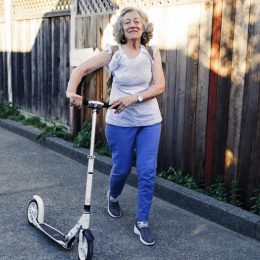4 Rules for Losing Fat, Not Muscle
Maintain your strength as you shed pounds and lose fat with these proven strategies.

When you lose weight, those pounds can come from either fat or muscle. And you don’t want to lose muscle, especially as you get older.
Not only does muscle help you stay strong and independent, but it’s a leading indicator of overall health and longevity. In fact, research shows lean muscle mass is better at predicting overall health than body mass index (BMI), a score that uses both your height and weight to provide a rough estimate of whether you’re underweight, normal weight, or overweight.
Unfortunately, one out of every three adults ages 60 and older suffers from severe muscle loss, called sarcopenia, according to an Age and Ageing review.
“Loss of muscle mass is one of the biggest causes of age-related decline,” says Caroline Juster, C.P.T., an elite trainer at Fitness Formula Clubs Union Station in Chicago. “Older adults who get or stay strong can continue to perform daily tasks and active hobbies with fewer limitations. They also have a much lower risk of injury from falls and other accidents.”
What’s more, when we lose muscle, our metabolism slows, making it harder to lose or maintain a healthy weight, Juster says. Lean muscle mass is a primary factor in basal metabolic rate, or the number of calories your body burns per day simply by living.
“The more muscle we hold on to, the better we will look and feel, and the easier it will be to lose fat,” Juster says. And those are the pounds you want to lose.
Here are four strategies to help you stay strong and retain—or even build—muscle as you drop pounds.
Get and stay fit with SilverSneakers! Choose from dozens of different Community classes, visit a participating fitness location, or view the current schedule of SilverSneakers LIVE online classes here.
Fat Loss Rule #1: Cut Calories Gradually
To lose weight, you have to maintain a calorie deficit, meaning that you use more calories than you consume each day. However, cutting your calories too drastically can lead to muscle loss, Juster says.
If you’re counting calories, aim to cut no more than 500 per day. That will keep you in the healthy, gradual range of losing one to two pounds per week.
You can achieve this deficit by cutting 500 calories from your regular meal plan, burning an extra 500 calories with exercise, or a combination of nutrition and fitness changes that lead to 500 calories total. The good news is cutting even 100 calories a day can help—and may be more manageable for some people.
Now sure how many calories you should be eating per day? It depends on how active you are. Check out our guide to calories. Or ask your doctor or a registered dietitian for guidance, especially if you have a chronic condition.
Fat Loss Rule #2: Focus on Total-Body Strength
To lose fat and build muscle, the bulk of your exercise time should go to total-body strength workouts, says Pete McCall, C.S.C.S., a personal trainer and author of Smarter Workouts.
Compound, multi-joint movements, such as squats, pushups, and rows, are especially beneficial. These exercises involve multiple large muscle groups, so they build strength—and increase your heart rate and burn calories with every rep.
“For those who are newer to the weight room, I recommend two days of strength training each week,” Juster says. “More experienced exercisers can do as many as three or four sessions per week.”
These workouts don’t need to be long or grueling, she says. “Start with 20- to 30-minute full-body workouts and build from there, focusing on improving your performance from week to week.”
That might mean gradually increasing the weight you use, performing more total reps during your workout, or simply executing the same workout with better form, Juster says.
“When you focus on performance in the gym or working out at home, you will maintain or even build muscle as you lose fat,” she says.
Here are some great total-body strength workouts for all fitness levels:
- The 30-Minute Total-Body Strength Workout
- A 15-Minute Chair Workout for Your Whole Body
- The Full-Body Resistance Band Workout
Try Total Body Strength with SilverSneakers! The fun 45-minute strength-training class is offered both in-person at participating fitness locations and online with SilverSneakers LIVE.
Fat Loss Rule #3: Double Down on Protein
The protein you eat contains the essential amino acids needed for your muscles to grow back stronger after each workout.
According to the National Academy of Medicine, the recommended dietary allowance (RDA) of protein for adults in their 50s and older is 0.36 grams per pound of bodyweight (multiply your weight by 0.36). But it’s important to know that the RDA is the minimum amount you need to meet your basic nutritional requirements.
For optimal health, older adults may need almost double the RDA of protein, according to mounting research. One 2015 study found older adults improved their muscle health by consuming 0.68 grams of protein per pound of bodyweight (multiply your weight by 0.68).
Subscribe to our newsletter
It's quick and easy. You could be one of the 13 million people who are eligible.
Already a member? Click to discover our 15,000+ participating locations.
Follow Us
For an adult who weighs 130 pounds, that’s about 88 grams of protein per day. For one who weighs 150 pounds, 102 grams. And for one who weighs 170 pounds, 115 grams.
If that seems like a lot, take it one meal at a time. Other research recommends adults consume between 25 and 35 grams of protein at every meal for both muscle health and weight loss.
If you’re not interested in counting your macronutrients, Juster offers this advice: “Try including one to two palm-sized servings of protein-rich foods like meat, fish, poultry, beans and legumes, or eggs with breakfast, lunch, and dinner,” she says.
And as with figuring out exactly how many calories you need based on your health, your doctor or a registered dietitian can help you figure out how much protein per day is right for you.
Fat Loss Rule #4: Use Cardio for Recovery
“For many people, the first step to losing weight is hopping on a treadmill or elliptical for hours of cardio,” Juster says. “This is a big mistake, because with excessive cardio, we often lose our hard-earned muscle along with our extra fat.”
Avoiding excessive aerobic exercise doesn’t mean cutting it completely—after all, it’s a vital part of a well-rounded exercise plan. But for weight loss, it may help to think of it as a method to help your body and muscles recover in between strength sessions.
Research in the American Journal of Physical Medicine and Rehabilitation shows low-intensity aerobic exercise is an effective way to promote muscle strength and recovery after challenging workouts.
On the days you don’t perform strength training, make a point to complete at least 30 minutes of gentle, low-intensity movement such as walking, cycling, or swimming, McCall says. Choose a pace that allows you to carry on a conversation—without huffing and puffing.
Take Your Favorite SilverSneakers Classes Online!
SilverSneakers members can access live fitness classes and wellness workshops through SilverSneakers LIVE. See the latest schedule and RSVP for classes here.
Not a member? If you have a Medicare Plan, it may include SilverSneakers—at no additional cost. Check your eligibility instantly here.
Not eligible for SilverSneakers? You can still get 200+ free SilverSneakers On-Demand videos and stay in touch with us by creating your online account.





